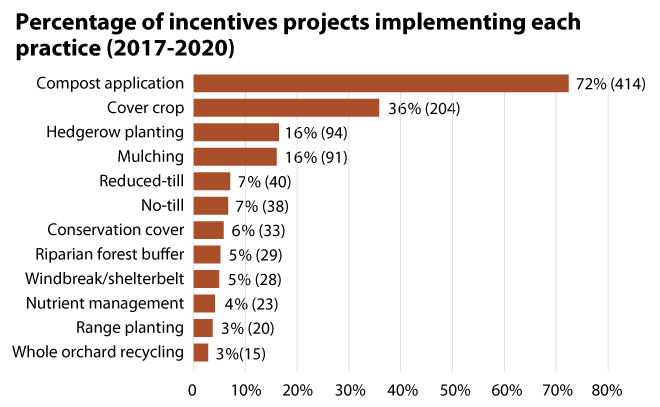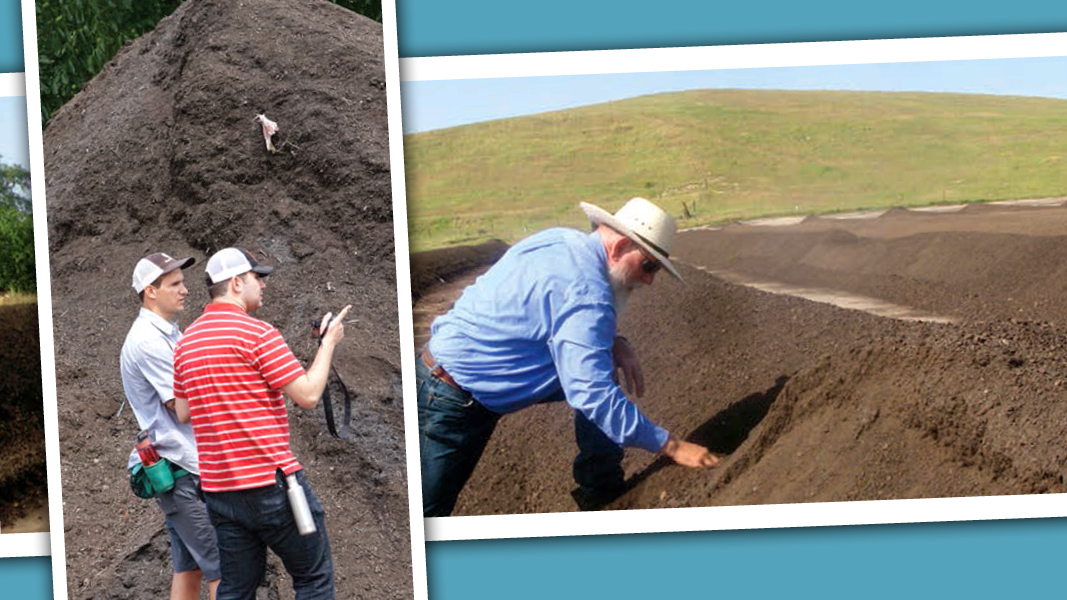California’s Healthy Soils Program (HSP) was established in statute in 2016, with the mission to “optimize climate benefits while supporting the economic viability of California agriculture by providing incentives, including, but not limited to, loans, grants, research, and technical assistance, and educational materials and outreach, to farmers whose management practices contribute to healthy soils and result in net long-term on-farm greenhouse gas benefits.” The program, administered by the California Department of Food and Agriculture (CDFA), was the first state-led effort of its kind to offer farmers financial incentives to adopt soil health practices to reduce greenhouse gases and increase carbon sinks.

Source: Top photos of on-farm composting and figure excerpted from Healthy Soils Program Progress Report
A December 2020 Healthy Soils Program Progress Report was released by California Climate and Agriculture Network (CalCAN), a statewide coalition of sustainable farmers and ranchers, allied organizations and other stakeholders. The report provides a brief overview and history of HSP, discusses notable achievements and program elements worth replicating in other states, and “identifies opportunities for program improvements that the CDFA is well positioned to address,” notes CalCAN. Finding #4 of the report is a ringing endorsement of using compost to build healthy soils. “HSP incentivizes a diverse range of practices, with compost application by far the most popular. … Overall, soil management practices (compost, cover crop, mulch and tillage) were most frequently implemented. Compost application outpaced all other practices with about 72% of incentives projects implementing the practice. Cover cropping was the next most popular practice, included in 36% of projects. Hedgerow planting was the third most common practice at 16%, while other conservation plantings were much less commonly used. The most popular practices — compost, cover crops, mulching, and hedgerows — provide important benefits for erosion control and water infiltration and retention, in addition to their climate mitigation benefits.”
Since 2017, HSP has provided over $42 million to 640 projects on farms and ranches, including 67 demonstration projects. Notes Finding #1 in the report, “HSP successfully catalyzes immediate adoption of healthy soils practices across the diversity of California agriculture’s cropping systems and geographies.” Conventional farms receive the majority of HSP grants (79% as calculated by California Certified Organic Farmers). This is due in large part to the fact that HSP’s guidelines prevent farmers from applying for incentives for practices they are already implementing. Organic operations tend to use many of the healthy soil practices included in the HSP.
In 2018, CalCAN launched the National Healthy Soils Policy Network, a group of farmer-centered organizations that advocate for state healthy soils policies. A summary of the status and focus of healthy soils bills in the U.S. is available on a frequently updated webpage managed by Tufts University. Some of these states have borrowed language and various program design elements from California, according to CalCAN. The webpage has the best URL — nerdsforearth.com!













